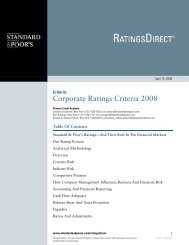European Infrastructure Finance Yearbook - Investing In Bonds ...
European Infrastructure Finance Yearbook - Investing In Bonds ...
European Infrastructure Finance Yearbook - Investing In Bonds ...
Create successful ePaper yourself
Turn your PDF publications into a flip-book with our unique Google optimized e-Paper software.
TRANSPORTATION INFRASTRUCTURE<br />
80 ■ NOVEMBER 2007<br />
included to allow the issuer to make a drawdown<br />
under the liquidity notes in the event of a<br />
shortfall, and to enable the trustee to serve a<br />
notice of demand under the financial guarantees<br />
in the event of a payment default under the loans.<br />
The interest paid by each class of notes is<br />
summarized in table 3 on the previous page.<br />
Redemption Profile<br />
If the issuer receives any unscheduled prepayment<br />
amount from the borrowers, it prepays the debt<br />
outstanding on a pari passu basis with the<br />
following priority:<br />
• Any amounts due and payable on the X<br />
certificates;<br />
• Any principal redemption amounts on the<br />
prepayment due on the corresponding<br />
tranches of the notes; and<br />
• Any make-whole prepayment to the<br />
corresponding tranche of notes.<br />
On a mandatory prepayment, the issuer prepays<br />
the notes pro rata, except where the prepayment<br />
relates to refinancing of all or any tranche of the<br />
permanent facility, in which case the proceeds are<br />
applied by the issuer to redeem the corresponding<br />
tranches of notes pro rata.<br />
Each class of notes can be paid in whole or in<br />
part, subject to certain prepayment penalties, and<br />
in a minimum amount of £5.0 million or<br />
€ 7.5 million.<br />
On a substitution event of the existing<br />
concessionaires and the acceleration of the<br />
permanent facility, the issuer sweeps cash received<br />
to redeem the notes, unless it can invest in<br />
eligible investments that replicate the payment on<br />
the notes.<br />
Early redemption and the authorized investment<br />
(AI) Option<br />
Under condition 10(h), the monolines hold an<br />
option that can be exercised upon a full or partial<br />
prepayment of the tranche A loan (that<br />
corresponds to class G notes at the issuer level) in<br />
case the proceeds from prepayment of the loan<br />
are not sufficient to pay the relevant note<br />
redemption amount plus the net present value of<br />
the financial guarantee fee, provided no loan<br />
event of default has occurred. This option allows<br />
the monoline to invest the amount prepaid (which<br />
normally would have been applied in redemption<br />
of the tranche G notes) in a defeasance account to<br />
be invested in authorized investments. Such<br />
STANDARD & POOR’S EUROPEAN INFRASTRUCTURE FINANCE YEARBOOK<br />
investments need to produce amounts at least<br />
equal to amounts payable in respect of the notes<br />
(including the guarantee fee) on each scheduled<br />
payment date in respect of this principal amount<br />
and in respect of the relevant proportion of the<br />
tranche A loan prepaid.<br />
Practically, if the monolines exercise this option,<br />
they have to make sure that a defeasance account<br />
is opened with the issuer bank account provider<br />
in the name of the issuer--one for each class of G<br />
notes that would have been prepaid if the option<br />
were not exercised. <strong>In</strong> addition, a custodian is<br />
appointed with regard to defeasance accounts to<br />
hold the monoline authorized investments on the<br />
issuer’s behalf.<br />
The cash standing on these accounts together<br />
with the proceeds generated by the monoline<br />
authorized investments is taken into account in<br />
the waterfall for the payment of interest and<br />
principal of the relevant class G notes. This is<br />
because the loan has been prepaid and therefore<br />
no further interest or principal is paid by the<br />
borrower on that portion of the loan.<br />
If the tranche A1 or A2 loan has been prepaid<br />
in full and the authorized investment (AI) option<br />
has been exercised by the monolines, the trustee<br />
notifies the tranche G noteholders. Once the<br />
noteholders have been notified, within 30 days,<br />
they can ask to redeem the tranche G notes<br />
that they hold to the extent that the notes<br />
would have been redeemed had the prepayment<br />
not been the subject of the AI option. The amount<br />
received by the relevant tranche G noteholder<br />
follows the payment of amounts due to the<br />
relevant monoline.<br />
Issuers’ pre-enforcement priority of payments<br />
Before enforcement, the issuer applies the<br />
available funds plus any liquidity drawings, save<br />
that (i) if the monoline has exercised the AI<br />
option, any AI receipts generated from a certain<br />
defeasance account are used only to pay the<br />
relevant monoline or the relevant class G<br />
noteholder for which that account has been<br />
opened, and (ii) if the noteholders have<br />
exercised their AI option, the amounts received in<br />
the relevant defeasance account are used only to<br />
repay the relevant monoline, in the<br />
following order:<br />
• Senior expenses related to the transaction,<br />
including trustee fees, rating services fees,<br />
and corporate servicer fees, total return



